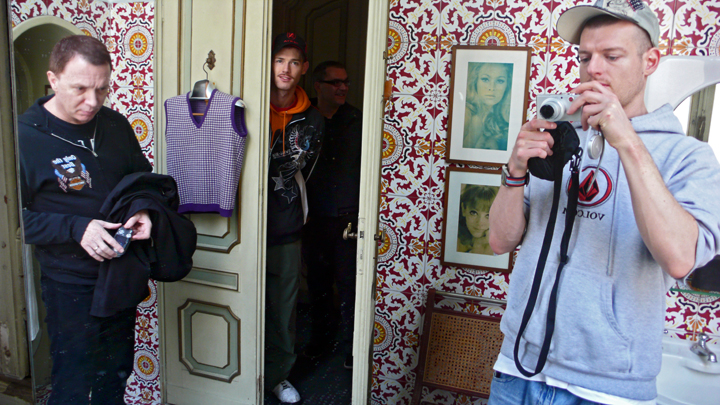Hangover at Casa Mollino
Essay for Pin-Up Magazine, Fall/Winter 2008/09

Italians sure know how to party! Invited to Italy on the occasion of the International Gay & Lesbian Film Festival in Turin, Brian Kenny and I enjoyed exquisite food and wine in a company of fellow renegade artists and bohemians (Bruce LaBruce, Peter "Sleazy" Christopherson, Ron Athey, Christophe Chemin, Terence Koh and Gio Black Peter, to name just a few). But it’s the local specialty, a cocktail called Negroni, that got us into trouble. Made of 1 part gin, 1 part vermouth, and 1 part Campari, it’s the most popular party drink in Italy. Consumed in quantity, it triggers the most painful, excruciating hangover I’ve ever experienced in my life (and, being Russian, I’ve experienced plenty). The jolly Italians just kept on shoving those Negronis on us at each and every reception, party and dinner. To the end of my life I will remember the bitter-sweet smell of Negronis that makes me nauseous…
On the last day of our stay in Turin, my friend Jacques Reynaud arranged for us to visit Casa Mollino, the house-museum of the legendary Italian architect, furniture designer, car racer, stunt pilot, and all-around Renaissance man Carlo Mollino (1905-1973). A notorious playboy who collected race cars and airplanes, Mollino was known during his lifetime mostly for his architecture and unique—organic and very sensual, one-of-a-kind—furniture pieces. But he was also an occultist and one of the greatest erotic photographers ever. Mollino never married and didn’t have any direct descendants, but when he died he left behind a vast archive that included hundreds of private nude photos of local female prostitutes. These highly stylized and often hand-retouched Polaroids were considered a rather scandalous and even shameful part of Mollino’s oeuvre until they were re-discovered in the mid-'80s. But unlike his furniture pieces, which have been selling at record-high prices at auctions such as Christie’s, Mollino’s photos didn’t have much of a market at first (Jacques recalled that they used to sell for a couple of hundred dollars a piece).
The house—a picturesque two-story 18th century villa on the Po River in the heart of Turin’s historic center—is a fascinating and somewhat spooky place where the master himself carefully designed every interior detail. And although he’d owned it since 1960 and spent 13 years decorating it, working there and taking his private photos, he never spent a single night at Casa Mollino.
The legend goes that Mollino was fascinated by the ancient Egyptian pyramids, in particular the tomb of the royal architect Kha (ca. 1390-1352 BC), discovered during his lifetime and displayed at a local museum. Just like Kha, who decorated his own future tomb in his spare time, Mollino wanted to create a sort of magically surreal and mystical environment filled with his favorite objects, which he wanted to carry into the Kingdom of the Dead. Casa Mollino was his private pyramid, his “warrior’s house of rest,” away from the luxurious apartment he otherwise shared with his devoted housekeeper.
When we arrived at Casa Mollino, we were greeted by its current owners, Fulvio Ferrari and his son Napoleone, who are responsible for preserving the original interiors and who have published numerous books on Mollino’s work. Napoleone, fluent in English, gave us a private tour of the villa, filled with Mollino’s memorabilia and furniture—both original pieces and exquisite replicas. Rolling his eyes dramatically and folding his hands in prayer-like manner, he recited the pre-recorded mantra of curious facts and anecdotes on Mollino’s eclectic life and career.
There was so much devotion and dedication in Napoleone’s every word and gesture, it made me wonder if his infatuation with the Dead Pharaoh had almost religious nature. I found this odd couple—bearded bald father and his bearded balding son—just as fascinating as the place itself. For a moment I imagined what goes on there when the sun goes down and the “pyramid” transforms into a place of bizarre occult rituals, with Fulvio and Napoleone holding hands and posing as Mollino’s pin-up girls in high-heel shoes, fishnet stockings and slutty dresses, jumping on his Egyptian boat bed and evoking the spirit of their Master.
Suddenly I realized that this villa would be a perfect set for a drag queen cabaret where even the most grotesque characters and outrageous costumes would fit right in. Then I wondered if Pharaoh Mollino himself was a cross-dresser who was buying all those campy outfits not so much for his models but for himself—and whether Casa Mollino in reality was his secret tranny closet, his little fetish playhouse. Perhaps, this sudden vision was a product of my perverse imagination or just my terrible hangover. Blame it on those Negronis!